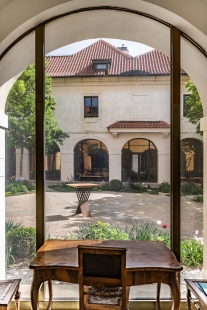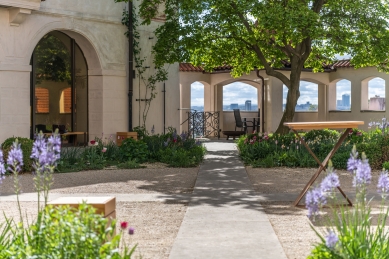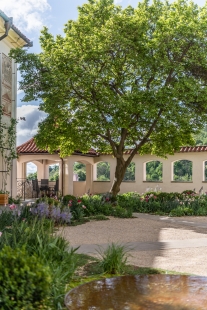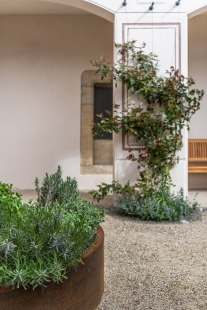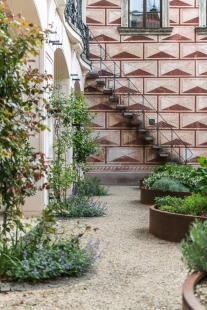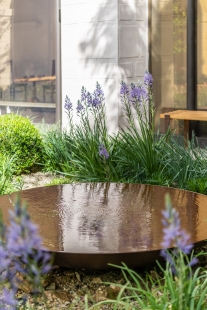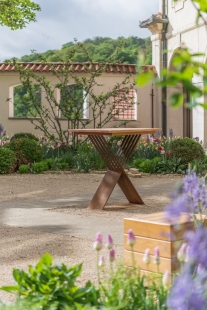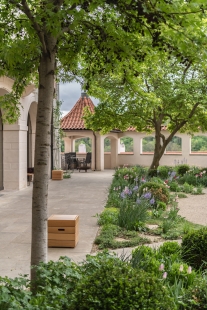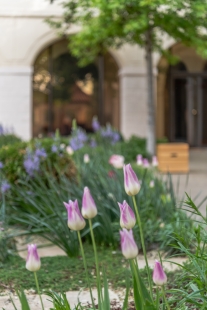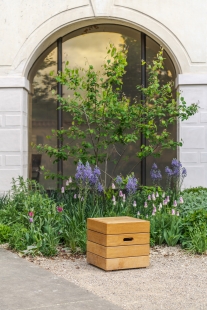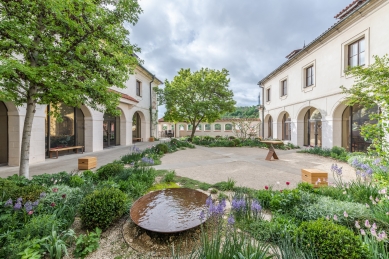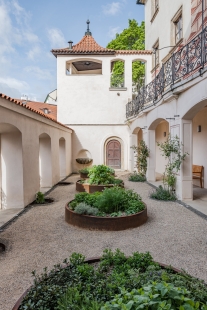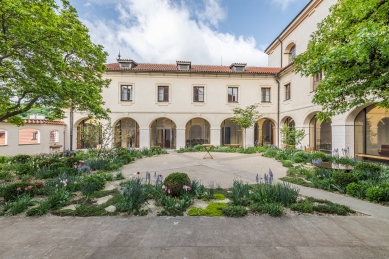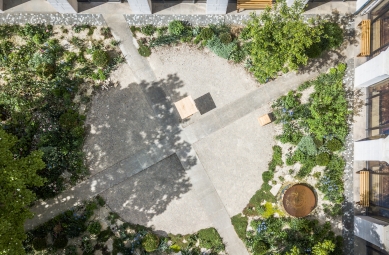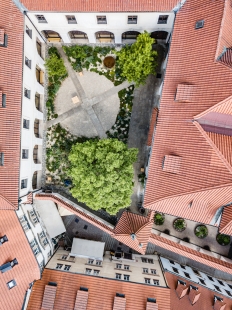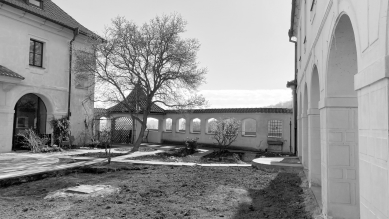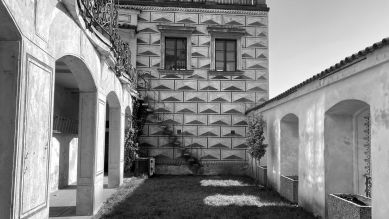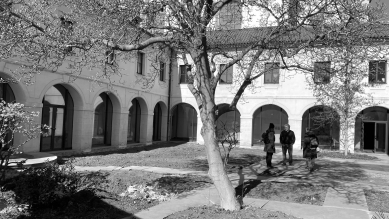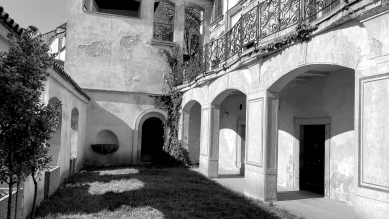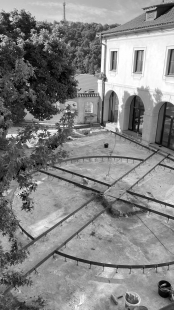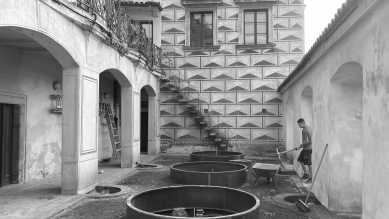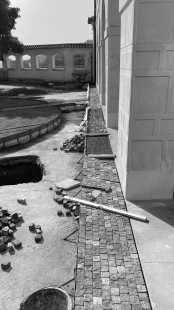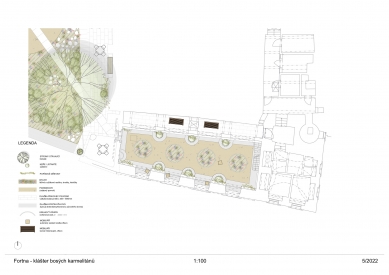
Fortna
Monastery of the Barefoot Carmelites in Hradčany

Fortna – Monastery of the Barefoot Carmelites in Hradčanské Square is a unique place with a rich history. The restoration of two gardens – the Paradise Courtyard and the Lower Terrace – took place here in 2022–2023.
The landscaping solution draws on the spiritual and symbolic significance of the place, connecting the past with the present while also responding to the changes that have occurred in the gardens over the previous decades. The design brings a general calming of the space, enhancing its aesthetic and functional qualities. The entire community – members of the choir and friends of Fortna – engaged in the revitalization of the garden. Their participation helped transform the space into a vibrant place with a natural connection to the local community and its needs.
Paradise Courtyard
The main compositional principle is based on the symbol of the Barefoot Carmelite Order. The cross on the summit of Mount Carmel is projected into the pavement in the form of a sandstone matrix, with its vertical axis symbolically directed toward the Carmel Mountains in Israel. Mount Carmel is indicated by a circular area divided by a cross into four quadrants. The three stars in the order's emblem are represented as a trio of trees – a magnolia, an ambron, and an ornamental cherry with delicately pink flowers. The composition is complemented by two multi-stemmed trees (a serviceberry and an ornamental apple tree) and a climbing rose trained on a trellis near the stairs leading to the terrace. These three smaller trees form a counterpoint to the three towering trees.
The meditative atmosphere of the Paradise Courtyard is enhanced by a water feature – a corten bowl with a calm surface reflecting the sky and surrounding architecture. The plantings around consist of perennials and shrubs, emphasizing seasonal variability, color, and fragrance.
The evergreen shaped shrubs visually represent a permanent element, in contrast to the perennials and bulbs that gradually change the garden with colors and structures.
The eastern side of the garden serves as a stone patio, providing a backdrop for various events. A path of small granite cobblestones runs around the Paradise Courtyard. The original sandstone pavement is preserved between the windows. The gazebo retains its current appearance, including the flooring surface.
Terrace
The lower garden (terrace) continues the tradition of utilitarian monastery gardens. In the new herb garden design, a four-axial rhythmic composition is applied. Four circular beds made of corten steel are planted with groups of medicinal and aromatic herbs categorized by effects and uses – from the kitchen to the decoration of the church.
The beds are surrounded by a gravel area, and a path of small granite cubes runs along the perimeter. The boundary walls are enlivened by gently curved beds. On one side, they are planted with hydrangeas, and on the other with climbing roses trained on wire trellises.
The composition is complemented by bulbs that help extend the flowering period throughout the growing season. The used bulbs are also traditional for monastery gardens.
Both areas are rooftop gardens located on a massive structure of historical cellars with substrate heights of up to 0.5 m. For the trees, the structure was supplemented with sufficiently large and deeper planting pits.
The entire community participated in the revitalization of the garden. Their involvement helped transform the space into a vibrant place with a natural connection to the local community and its needs. A public fundraising campaign was organized for the plant material, and the actual plantings were carried out by volunteers. Friends of Fortna contributed to the implementation under the guidance of the designers, Lady Veselá and Jan Sulzer. This joint effort, volunteer work, and the generosity of donors hold immense value for this place – they are expressions of trust, togetherness, and care that have been permanently imprinted in the space.
The landscaping solution draws on the spiritual and symbolic significance of the place, connecting the past with the present while also responding to the changes that have occurred in the gardens over the previous decades. The design brings a general calming of the space, enhancing its aesthetic and functional qualities. The entire community – members of the choir and friends of Fortna – engaged in the revitalization of the garden. Their participation helped transform the space into a vibrant place with a natural connection to the local community and its needs.
Paradise Courtyard
The main compositional principle is based on the symbol of the Barefoot Carmelite Order. The cross on the summit of Mount Carmel is projected into the pavement in the form of a sandstone matrix, with its vertical axis symbolically directed toward the Carmel Mountains in Israel. Mount Carmel is indicated by a circular area divided by a cross into four quadrants. The three stars in the order's emblem are represented as a trio of trees – a magnolia, an ambron, and an ornamental cherry with delicately pink flowers. The composition is complemented by two multi-stemmed trees (a serviceberry and an ornamental apple tree) and a climbing rose trained on a trellis near the stairs leading to the terrace. These three smaller trees form a counterpoint to the three towering trees.
The meditative atmosphere of the Paradise Courtyard is enhanced by a water feature – a corten bowl with a calm surface reflecting the sky and surrounding architecture. The plantings around consist of perennials and shrubs, emphasizing seasonal variability, color, and fragrance.
The evergreen shaped shrubs visually represent a permanent element, in contrast to the perennials and bulbs that gradually change the garden with colors and structures.
The eastern side of the garden serves as a stone patio, providing a backdrop for various events. A path of small granite cobblestones runs around the Paradise Courtyard. The original sandstone pavement is preserved between the windows. The gazebo retains its current appearance, including the flooring surface.
Terrace
The lower garden (terrace) continues the tradition of utilitarian monastery gardens. In the new herb garden design, a four-axial rhythmic composition is applied. Four circular beds made of corten steel are planted with groups of medicinal and aromatic herbs categorized by effects and uses – from the kitchen to the decoration of the church.
The beds are surrounded by a gravel area, and a path of small granite cubes runs along the perimeter. The boundary walls are enlivened by gently curved beds. On one side, they are planted with hydrangeas, and on the other with climbing roses trained on wire trellises.
The composition is complemented by bulbs that help extend the flowering period throughout the growing season. The used bulbs are also traditional for monastery gardens.
Both areas are rooftop gardens located on a massive structure of historical cellars with substrate heights of up to 0.5 m. For the trees, the structure was supplemented with sufficiently large and deeper planting pits.
The entire community participated in the revitalization of the garden. Their involvement helped transform the space into a vibrant place with a natural connection to the local community and its needs. A public fundraising campaign was organized for the plant material, and the actual plantings were carried out by volunteers. Friends of Fortna contributed to the implementation under the guidance of the designers, Lady Veselá and Jan Sulzer. This joint effort, volunteer work, and the generosity of donors hold immense value for this place – they are expressions of trust, togetherness, and care that have been permanently imprinted in the space.
authors' report
The English translation is powered by AI tool. Switch to Czech to view the original text source.
0 comments
add comment




